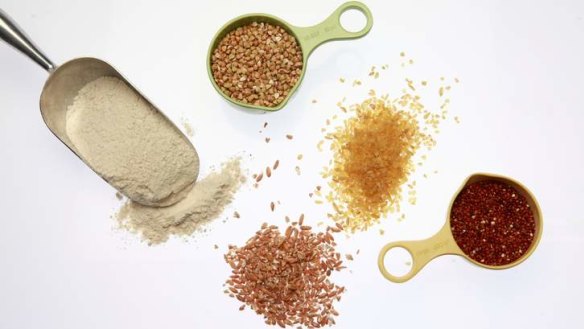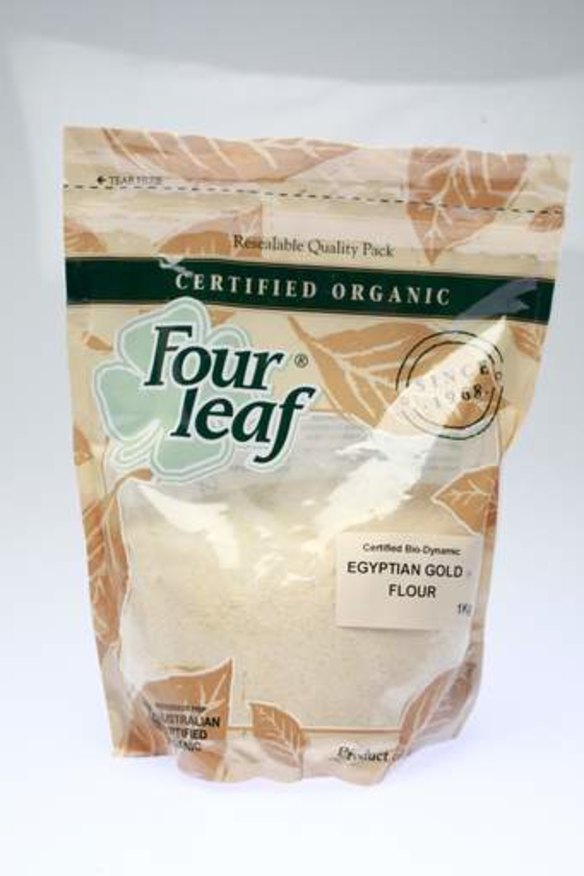Beyond the common grain

It wasn't so long ago that if you went to buy flour at the shops you had only a handful of options, such as brown or white and plain or self-raising. Now there is an abundance of seeds and grains on offer that until recently had only been available – and in demand – overseas. Many of these products have been spruiked for their health benefits, such as higher fibre content, omega-3 fatty acids and easier digestibility. Many are also gluten free.
While the health benefits of these seeds and grains may be many, the challenge for home cooks is in the preparation, so that they are equally as delicious and easy to digest as they claim on the packet. And in most cases, it's not just a matter of substituting them in place of flour products.
Chia seeds
Chia seeds are an excellent source of fibre (providing 38g per 100g serve). They also contain good quantities of minerals such as calcium, phosphorus and manganese.
They can be added to boost the protein content of dishes or to improve the texture and work in cakes, slices, bread loaves and smoothies. When mixed with warm water, they form a smooth, thick gel that can be used as a binding agent in cake mixes or a substitute for eggs.
Chia seeds originated from South America, where they were highly prized by Aztec groups as a source of valuable nutrition. Australia is now a major producer of the seeds, and many leading companies use sustainable farming techniques to harvest them.

Cooking and baking with chia: Try adding a teaspoon of chia seeds to a regular smoothie, a tablespoon to a regular seed or nut slice, or a topping of chia seeds over your morning breakfast cereal.
Chia flour can be made with a 1:1 ratio of brown rice flour and ground chia seeds. It lacks the glutinous durability and texture of wheaten flour, but it can be substituted for flour in most recipes if additional binders (such as eggs or arrowroot powder) are used.
Chia gel is a popular fibre supplement taken first thing in the morning. Combine 1 tsp chia seeds with 1/2 cup hot water. Stir well and drink immediately.
Egg replacement: Chia seeds can be used as an egg replacement in cake making – their viscose gel binds together ingredients just like egg whites do. A general rule is 1/4 teaspoon chia seeds mixed with 1 teaspoon warm water per egg in recipes containing only a few eggs required for binding (obviously, it wouldn't work so well in a pavlova).
Quinoa
Quinoa is a good source of protein – the white variety contains about 15 per cent protein, which is considerably higher than white rice (3 per cent) and cous cous (5 per cent). It is also an excellent source of dietary fibre. Many minerals in quinoa are found at higher concentrations compared with most grain crops, particularly when the plant is grown in rich volcanic soil. It is also a good source of B vitamins, phosphorus, magnesium, vitamin E and folate.
Quinoa is native to South America and was a sacred staple food of the Incas for more than 4000 years. It is grown in three striking colours – black, red and ivory. Ivory quinoa is the most common and versatile.
Quinoa is a pseudo-cereal crop – meaning that while it closely resembles a grain in its appearance and characteristics, it is not a member of the grass family, and is in fact more closely related to beets, spinach and tumbleweeds. It is gluten-free and a rich source of protein and fibre.
Quinoa seeds are easy to cook and prepare. Similar to rice, they require only quick, gentle cooking with water. Quinoa seeds can be used to make porridge, or savoury salads and stews. They are fairly plain tasting, so are best combined with sharp flavours such as lemon juice or zest, or a little vinegar and oil.
To cook, simply rinse well in cold running water (quinoa seeds contain a bitter compound called saponins on their skin, which requires this rinsing), then combine one part rinsed quinoa to two parts water in a small saucepan. Simmer with the lid off for 10-15 minutes or until the seed splits forming little curls and the water is absorbed. Season to taste. If you are using the seeds to make a salad, it is a good idea to toss through some olive or sunflower oil while still warm to prevent clumping.
Quinoa flakes are made from steam-rolled whole grain kernels. They can also be used to make a quick-cooking porridge.
For people that have difficulty digesting quinoa, try pre-soaking it for 12-24 hours in warm water with a half teaspoon of apple cider vinegar prior to cooking. Rinse well before use.
Baking with quinoa: Quinoa seeds can be ground into a flour called "quinoa flour", which is sold at most health food stores. You can also grind it yourself in an electric grain mill or with a KitchenAid grinding attachment.
The flour has a nutty, distinctive flavour, which is best combined with warm spices – such as ginger, cinnamon or nutmeg, or mixed with other flours to even out the flavour. It has a drier texture compared with wheaten flour, so it is worth adapting the ingredients to baking recipes by adding more wet and binding ingredients such as milk, eggs or arrowroot powder.
200g (1 cup) quinoa
2 cups Japla pumpkin, roughly cut into 1-2 cm cubes
1/2 cup finely chopped mint
1/2 cup finely chopped parsley
zest from 1/2 lemon
1 cup roasted hazelnuts
Method
1. Place pumpkin on roasting tray, sprinkle with a little olive oil or cooking fat and roast in preheated 180C oven for 20 minutes or until brown and crispy. Allow to cool.
2. Cook quinoa following the directions above. Drain well and allow to cool.
3. Crush the hazelnuts with a mortar and pestle, or a paper bag and rolling pin. They should be broken into halves or quarters so that they are easy to chew.
4. Combine all the ingredients together, adding the mint and hazelnuts at the end. Season to taste with salt, pepper and a dash of olive oil.
Variation: Try adding a half cup of dried cranberries for added zest, or a handful of crumbled fetta cheese for extra creaminess.
Buckwheat
Buckwheat contains as much as 20 per cent protein, which is considerably more than that contained in wheat, rice, corn or millet. Just like all grains, and grain-like substances, buckwheat's nutritive value is influenced by milling and refinement. This will influence the amount of fibre, protein and minerals available in the final product.
Deceptively labelled with the word "wheat" in its name, buckwheat is not actually a cereal grain. It is part of the polygonums family – a distant relative of rhubarb and sorrel, and bearing little physical resemblance to cereal grains. But despite this misnomer, it is actually a versatile grain-like ingredient, with a distinctive flavour that works beautifully well in pancakes, cakes and porridges.
Traditional Russian blinis are small puffy little pikelets made with sour milk, buckwheat flour and eggs. The original French crepe also uses buckwheat as its base, with milk and eggs used to thin the mixture out.
Buckwheat flour benefits from being pre-soaked in an acidic medium such as cultured buttermilk, sour cream or whey. The natural lactic acid in the fermented raw dairy food breaks down the indigestible, anti-nutrients that are present in the seed, making it easier to digest.
Buckwheat grouts are the whole kernels with the hulls removed. They were traditionally sprouted and ground up into a nutritious, low-budget porridge or stew. They can also be roasted or boiled with stock and herbs to make the well-known Russian "Kasha".
Baking with buckwheat: Buckwheat does not contain gluten, so it lacks the elasticity and natural rising properties required for bread-making. However, it can be used as a flavouring agent in breads and pastries, when combined with other flours.
Bulgur (also known as bulghur, bourghul and burghul)
Bulgur is a cereal food made from the one of the oldest cultivated grains known as durum wheat. It originates from Africa and the Middle East where it is usually sprouted, boiled and then pounded to remove the bran and germ. The endosperm is left in large course chunks, which can be used to make dishes such as tabouleh, salads, soups or pilafs.
Bulgur is a highly nutritious, easy to prepare food that stores well for several months.
For cooking purposes, it needs to be reconstituted by placing 1 cup bulgur with 2½ cups of boiling water or stock. Leave it to rest for 30 minutes before draining off the excess liquid in a sieve or cheese cloth.
Shopping tip: Bulgur flour is defined by its level of coarseness – fine, medium, coarse and very coarse. The fine varieties can be used in puddings and kibbe. The medium varieties are good for salads such as tabouleh, and the course varieties can be made into soups, salads or pilaffs.
Spelt and kamut
Spelt and kamut grains are ancient heirloom varieties of wheat that have managed to avoid many of the pitfalls of domesticated wheat, such as selective breeding in favour of increased yield and raised gluten content. In comparison, spelt and kamut have maintained much of their original integrity, making them easier to digest and full of nutrition.
Both spelt and kamut (sometimes called Egyptian gold) also have a higher protein content than modern wheat (about 14-17 per cent protein compared to about 11 per cent for conventional wheat).
Just like all grains their nutritive value is influenced by milling and refinement. This will influence the amount of fibre, protein and minerals available in the final product.
Spelt and kamut grains are available as berries, cracked, pearled, flakes, puffed, or ground into finely milled or wholegrain flour.
Whole berries and pearled varieties can be pre-soaked and sprouted with a little vinegar and water, before being cooked to a soft, easily-palatable consistency.
Both grains benefit from a period of fermentation prior to cooking – it might be a leavening process with a traditional sourdough bread culture, or a period of pre-soaking or sprouting prior to cooking. This process reduces the phytic acid content of the grains and renders them more easily digestible.
Cooking with kamut: Kamut grits make a tasty porridge when soaked overnight with a little yoghurt or sour cream, then cooked the next day just like oatmeal porridge.
The flour can be a good substitute for wheat flour in most recipes, however it will result in a denser, heavier loaf or pastry. Because of the large grain size and high protein content, kamut is better suited to making pasta than bread. For bread making it is best combined with other grains.
Cooking with spelt: Spelt flour is available in fine white and wholegrain varieties. Finely milled varieties have been bleached, with much of the wholegrain fibre removed. The wholegrain variety contains more nutrients and fibre.
For the purposes of baking, spelt flour lacks much of the elastic durability of conventional wheat, but it still achieves good results. It can replace wheat flour in most recipes, but it works best for pie-crusts and flat breads. Bread-makers often use spelt in conjunction with other flours, adding a little conventional wheat flour to achieve a good rise in the loaf.
The best recipes from Australia's leading chefs straight to your inbox.
Sign upFrom our partners
Original URL: https://www.theage.com.au/goodfood/tips-and-advice/beyond-the-common-grain-20130413-2hs3m.html